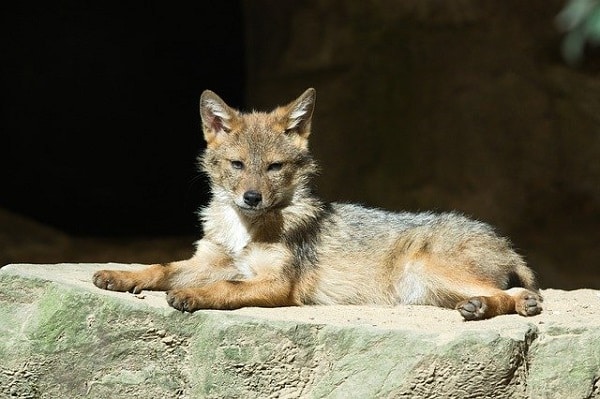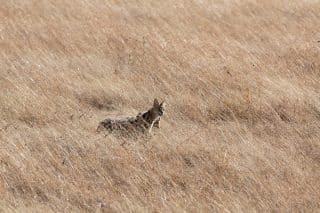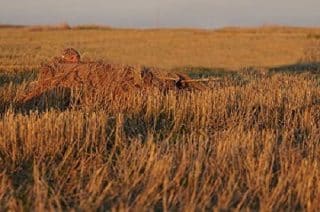Whether it’s because of their pelts or because they’re pests, hunting coyotes can be very frustrating if you’re not properly prepared.
With incredible olfactory senses, a coyote can and will smell you coming if you don’t take precautions to distract and put your coyote prey at ease.
That’s where coyote bait and lure traps come in. This list has five suggested products that can be used to bait coyotes right into your sights.
Below that list we’ve also written out a small buyers’ guide including an FAQ section. These will help you to not only learn about baits but also learn about the process of hunting coyotes and other tips to be used with the bait to ensure a successful hunt.
If you know what to look for before making your purchase, there’s less chance of you getting baited into a bad deal.
In a hurry?
This is our Winner!
Our Pick
If you’re in a rush to hunt some coyotes and just want to grab the best bait and leave, we recommend the Mark June Widowmaker Paste Bait.
We did because of the quality of its ingredients and the fact it was treated to last longer. See how they did that in detail below:
- A #1 selling bobcat bait paste made from bobcat meat with mink glands and beaver castor in them.
- Hormonal secretions from the mink that better attract predators.
- Includes lanolin which makes this bait extra-long lasting and resistant to dry, wet, and harsher weather conditions.
- A good baseline bait that can be combined with other types of lure to create an effective bait but performs just well enough alone.
Best Coyote Trap Bait - Comparison Table
Rank | Product Image | Product Name | Buy on Amazon |
|---|---|---|---|
1 | |||
2 | |||
3 | |||
4 | |||
5 |
Best Coyote Trap Bait - Reviews
The first product on our list is probably the best named, but don’t worry, that wasn’t the only reason it made it to the top of the list.
Mark June’s Widowmaker Paste Bait is a paste that’s made with bobcat meat, mink glands, and beaver castor to, as it says on the tin, attract bobcats. It does so well that it's Amazon’s Choice for bobcat lure searches.
Don’t worry though, this #1 selling bobcat meat also attracts coyotes and other canids like foxes. The ingredients used are high quality and, so that these tubs aren’t a waste of an investment on both yours and Mark June’s part, the bait paste is treated with lanolin.
The lanolin keeps the bait activated even after excessively wet or dry weather so that this bait can keep performing for longer.
The Widowmaker paste is compatible with most other lures for if you want to make a bait hole that is irresistible to the local coyote population. In those cases, the high-quality meat ingredients would make a good base.
The high quality of the ingredients used in this product aren’t without a downside, however, as it’s the most expensive product on the list. That said, the price hike between other items on the list isn’t too significant, and we wouldn’t have put it here if we didn’t think it was worth it. Before you leave, why not check out our best coyote calls guide - and see what our top picks are.
Pros
Cons
The next product on our list is an example of natural coyote urine bait, the Trap Shack Company Coyote Urine bottle.
As mentioned, the urine is all natural which, besides from creating an ungodly smell, varies from batch to batch since the urine is dependent on the diet and other lifestyle factors of the coyote it was taken from.
This means that it’s a great suspicion remover, since it’s not one synthetic scent that coyotes can learn to grow suspicious of, it’s different with every bottle.
It’s also handy to apply in the wild since it can be placed on the bark of trees or the base of most plants, just keep it away from any plant you may want to eat from because, uh, why do that?
Urine has a lot of uses beyond removing the suspicion of, and so drawing closer, any roaming coyotes out there. It can be a cover scent, too, and it’ll also chase away small animals like rabbits, squirrels, and most rodents (with some exception) that could plague your garden. Who knew urine was so useful?
That exception to this urine’s repellent effects seems to be the mighty and majestic groundhog. Yes, groundhogs. If you have groundhogs in your area, you should know that several have reported this urine attracts groundhogs. It’s not as impressive a prey as a coyote, we know.
Why? We’re not sure. They’re not the natural predator of the coyote according to everybody we asked, but we suppose consensus has been wrong before.
Joking aside, other precautions can be used to limit groundhog interference. Unless your area is swarmed by groundhogs, the product should work fine. Be sure to check out our list of the best coyote mouth calls for more great items like this.
Pros
Cons
The next product on this list is a Milligan Brand’s product, the Tutti Fruitti Dog Proof Animal Lure. This is a sweet-smelling lure that’s ideal for calling coyotes over to snares or other forms of entrapment.
It’s useful for coyotes, hence its place on the list, but is also effective at attracting foxes and racoons.
What it doesn’t appeal to is domestic dogs, so there should be minimized risk of accidentally ensnaring someone’s pooch.
Coyotes can become used to, and so suspicious of, certain scents, and having a fruity lure in your arsenal is a great way to combat this by keeping the coyotes unsure of which scents are safe or not.
However, whilst it may make you less predictable to the coyotes, the sweet smell of this bait doesn’t have as potent a scent as meaty lures and baits.
This means that it won’t spread as far as meaty baits and is best used early on into the hunting season so that the coyotes aren’t distracted by more attractive baits. Find more great products like this by checking out our guide to the best predator hunting lights
Pros
Cons
A special product from Hawbaker’s, the Coyote Food Lure 500 is a season-long lure made with longevity and efficiency in mind.
It also doesn’t suffer from too rotten an odor like many different food lures do, instead being aged just right so that the meat can air properly to attract coyotes whilst not turning the stomach.
What the Coyote Food 500 has over the same brand’s Coyote Food 200 is its gland content, so you can be assured that the scent of this lure will still be potent and effective on the noses of coyotes, and you’ll get more mileage from it in low-wind conditions.
It also attracts other animals such as foxes, raccoons, opossum and even deer sometimes, so this can be a good all-rounder bait but bad if you don’t want other critters being attracted into your rifle range, or worse, your carefully set snares.
Pros
Cons
Last up is Milligan’s Predatory Chunk Bait, a bait that mixes both the traditional meat-based bait with the sweeter flavors that fruity lures tend to have to pique coyote curiosity.
This makes for a hybrid bait for a best of both worlds situation that should bring in the coyotes.
Coyotes are prone to having a sweet tooth, so mixing a sweet flavor into the meat should give this an advantage over other baits.
Perhaps due to the fact that it combines what are usually two separate types of bait, this is one of the pricier products on the list, and the mix of meat and sweetness reduces how much the scent of this bait travels.
Pros
Cons
Best Coyote Trap Bait - Buyers Guide
How to choose the best coyote trap bait
We wrote this buyers’ guide so that you can not only see what makes one coyote trap bait better than the other, but also to include vital information about the process of using the baits themselves since this is vital.
These will be explored in the following parts: Types of coyote baits, when coyotes should be hunted, what attracts coyotes, and how to bait coyotes.
Types of Coyote Bait
The main types of bait you’ll see are genuine urine baits, genuine meat chunk baits, synthetic baits, and even lures that have a sweet and fruity smell and taste.
Urine baits are bottles that contain the urine of coyotes, though the urine of other carnivorous animals similar to coyotes can be attractive too.
There’s not much else to say than that. They usually come in strong, odor proof bottles since, as you can imagine, they don’t smell very pleasant to us, and the odor needs to be very strong to spread far and wide to attract coyotes from as wide an area as possible.
Urine of carnivorous animals like coyotes are also very useful for keeping critters like squirrels away, since they learn from the scent that there’s an animal that poses danger to them in the area.
Meat chunk baits are simply aged and fermented meat waste that also has a very strong smell to better attract coyotes. It’s also possible to get gland lure, which is better when fresh, since they give out gland excretions that attract your targets.
Like with urine, the glands of bobcats and foxes can suffice in attracting coyotes, too. We’d recommend buying genuine when looking for any bait or lure, whether it’s meat, urine, or gland.
This is because synthetic baits are a mixed bag, since they emulate the smell of whatever they’re trying to present as, whether that’s urine, meat, or even blends of fatty acids intended to mimic the vaginal secretions of canid species.
Coyotes’ noses are so fine that they can tell with many baits whether it’s the real deal or not. At that point it’s up to the curiosity of the coyotes whether they come close enough to get hunted, and so many prefer natural ingredients wherever possible.
As for the sweet lures, they’re only useful for a very short time in the early hunting season, before things get hectic for the coyotes and they’ll become too wary to find some sweet scent that’s passed their noses.
They’re also widespread in what they attract, attracting foxes and raccoons too.
The Best Coyote Hunting Time
Coyotes are largely nocturnal creatures, but we’re willing to assume that you’re not. A healthy compromise for the both of you (or just you, really) is to hunt at dawn and dusk when you still have some visibility to work with.
Coyotes will have just started to wander around these times, and you won’t have to invest in some night vision scopes.
On a seasonal scale, most seasons you won’t see much of a difference, but coyotes tend to stay out longer into the day depending on how cold it is.
This means that your chances of lucking across some coyotes during the daytime increase for fall and winter, when it’s typically colder, and you’ll have more luck if you live in colder areas.
Where the baits themselves are concerned, it should be noted that the temperature and humidity of the area needs to be taken into account. This is because bait and lure smells travel further in warmer and humid conditions, increasing your chances of gathering coyotes from the surrounding area.
What Attracts Coyotes
Like any animal in the canid family, coyote noses are extremely sensitive and act as their primary way of navigating and making sense of the world. This needs to be taken into account when hunting them as, if there’s any animal you definitely need to get upwind on, it’s the ones in the canid family.
A coyote suspicious of your scent will never get close enough for you to take it. This is why any bait should be set downwind too.
Other ways to ensure coyotes are attracted are calls and imitations. These can help to put coyotes at ease and even coax them closer to your trap, and so further into your crosshairs. We wouldn’t advise this is something you try until you’re adept at it as, just with the scents of the baits themselves, coyotes will tell what is authentic and what is fake.
Where to Bait Coyotes
Coyotes live in all kinds of habitats, from deserts to tropics and most places in between. They can even be found in cities, especially deserted areas.
They’re found in 49 of the 50 US states, and you can probably guess what the exception is. In some states coyotes are pests, but in others the coyote is a protected species, so learn the law at your local area before planning anything and making any new purchases directly related to coyote hunting.
Frequently Asked Questions
Can carcasses be used as bait?
They can, in fact. If you can spare the extra effort, the parts of other animals can be effective bait. The two best ways to use carcasses as bait for coyotes are either to use already dead roadkill, or to set up some offal from small game you can kill whilst hunting for coyotes, like rabbits.
You’ll have to check the legality of using roadkill, and dispose of it responsibly, but larger roadkill like deer will be guaranteed to attract some attention from some kind of scavenger, whether those scavengers are the desired coyote will be up to you scouting the area and making sure some are around.
Otherwise, kill some other game and use their guts as bait. It could be squirrel or rabbit, or even larger game. Dead deer works best for coyotes in every circumstance, but it could be too big an investment to bag a whole deer just for baiting purposes.
Whichever way you go with, place the bait somewhere you can easily aim at, make sure you’re upwind, and then play the waiting game.
What is the best cartridge for coyotes?
Any talk of cartridges, especially when comparing them to one another, is bound to cause some controversy. Coyotes get hunted with everything from .22LR to .30-06 Springfield cartridges, so most cartridges can take down coyotes. Some even use 12-gauge buckshot loads in order to hunt coyotes.
The .22 family get a bad rap in many gun enthusiast communities simply due to their low velocity and thus lower damage, but .22 magnum rounds have been a favorite for pelt hunters because of the fact they leave the pelt mostly intact whilst securing the kill.
Hollow points are the best to use since they’ll spread further inside the coyote, maximizing damage, though you should always be aiming for the heart or the head when firing .22s.
Otherwise, if you want something with a little more kick, .223 Remington will perform much further than the .22 at about 300 yards, or even better the .22-250 Remington will fly 400 yards, given a neutral environment and line of fire.
A good and trusty cartridge that most rifles are chambered for are the .243 Winchester cartridge, which can support a wide variety of loads due to how prevalent they are.
What is the best time of day to call coyotes?
Like baiting the coyotes, calling works best at certain times and at certain conditions. You may get results all year round due to how prevalent coyotes can be, but the best time during the day seems to be in the transitions between night and day, that is the first few hours in the morning and the last couple of hours before dusk.
There are more specific conditions that may help you if you’re calling, however. Hunters have reported more success when calling before or after a storm, but these are sporadic and unpredictable conditions for the areas that most hunters will be based at.


